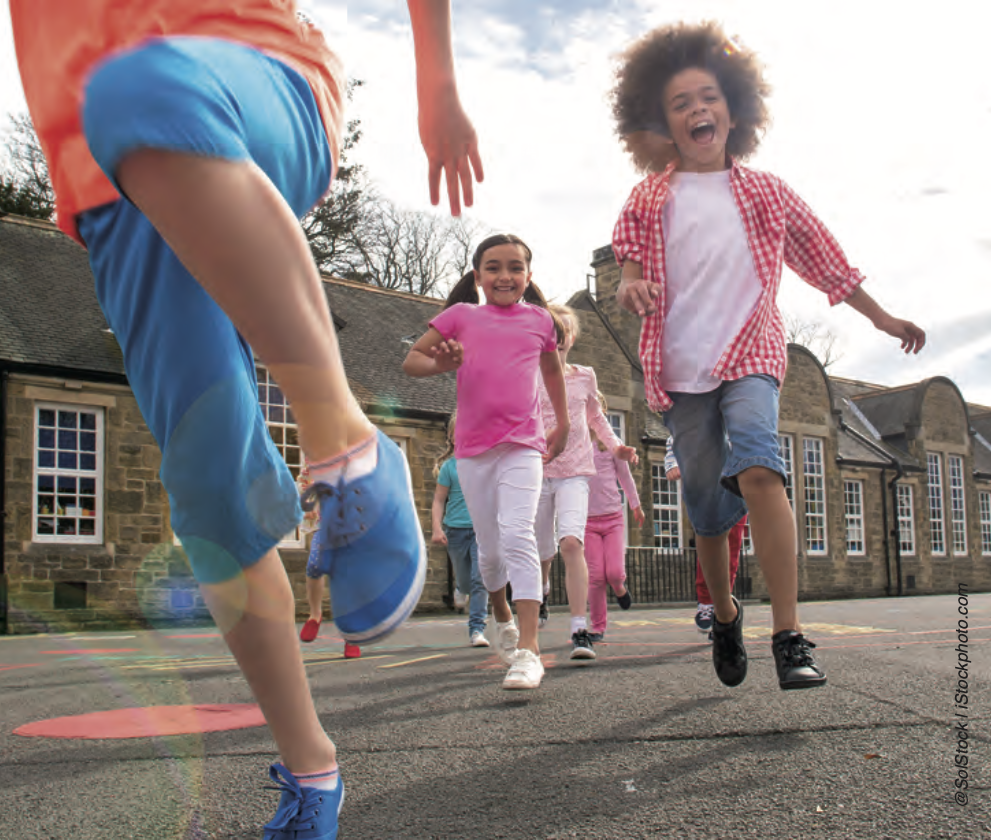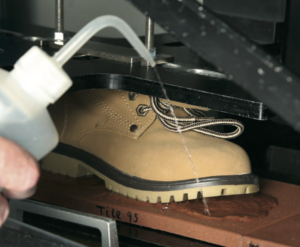Slip resistance of children’s shoes

Mike George explains the differences in slip resistance testing between children’s and adult’s footwear, and the reasons for them.
.
Falling over is a natural part of growing up, as children learn how to move and balance, discover their own physical limitations and the amount of grip offered by underfoot surfaces of all kinds. We only learn the boundaries by attempting to go beyond them. In a basic sense, children’s shoes need to have broadly the same slip resistance as adult’s shoes which, ultimately, the children will develop into wearing. It is mostly a case of weeding out unsuitable footwear from the lower end of the slip resistance spectrum.
During normal play, children wear their shoes more vigorously than adults do, so shoe soles need to offer materials and tread designs suited to a degree of athletic use. This includes all school shoes, as well as leisure shoes. Certain materials will tend to be favoured and functional tread patterns will normally need to be present. Children will still fall down for all sorts of reasons, but the footwear industry should ensure that it is not the avoidable fault of the shoe when they do.
Historic UK slip, trip and fall accident data (collected in hospitals in the early 2000s) shows that the vast majority (84 per cent) of fall accidents to 5- to 14- year-olds requiring medical attention occurred during playing, sports, ‘walking or running for need’ or ‘walking or moving about generally’ – these being some of the defined categories. Avery similar proportion (85 per cent) covers these same activities when the subset of such fall accidents which is known to definitely be ‘slips’ is considered. The locations of all the slip accidents were mainly (at least 69 per cent) outdoors – on roads, pavements, school playgrounds, sports surfaces, grassy areas, ice or snow and wooden floors. Frequently, the surface was identified as having been ‘wet’. This data-gathering exercise has not been repeated in the UK in recent years, but there is no reason to suppose that the broad picture is no longer true. Outdoor multi-surface play is the main performance challenge that children’s soles must meet for resisting slip.
Testing friction
A number of years ago, SATRA identified ‘running to a stop’ as a normal and foreseeable child’s playground activity. In this action, the whole sole, making flat ground contact, is used to arrest rapid forward motion. This obviously exerts higher friction demands than normal walking. So SATRA’s test regime has a well- established ‘forwards flat’ test mode, which is added to the heel and forepart test modes used as standard for walking footwear – both adult’s and children’s. One of the reasons for retaining these two test modes for children’s footwear is that they assess both heel and forepart sole areas separately. This is valuable if the materials or tread patterns differ between those areas.
Human biomechanics demand a minimum coefficient of friction (CoF) value of 0.30 for walking, but potentially in excess of 0.50 for vigorous activity. The CoF actually available may be measured by the SATRA TM144:2011 – ‘Friction (slip resistance) of footwear and floorings’ test method, using the SATRA STM 603 test machine. Experience in testing and considerable customer returns data has led to the SATRA minimum CoF guideline being adjusted to 0.40 for the flat contact test mode on the standard quarry tile test surface (both dry and wet). This was announced to members in August 2017. However, if testing is done on bespoke surfaces (such as tarmac or other actual outdoor surface) the advisable target is 0.50. The quarry tile is a little less inherently slip-resistant than typical outdoor surfaces, and the SATRA guideline takes account of that.
As well as minimum values of CoF, we also suggest a maximum advisory level of 1.25 (again, with a quarry tile), to prevent a significant risk of tripping or stumbling due to excessive grip. There is no biomechanically-based CoF value (the exceeding of which turns good grip into problematic adhesion), but we suggest that it is needless to engineer a higher CoF than 1.25 into a sole. Products giving results below 1.25 should minimise such problems.
General recommendations

Assessing the slip resistance of a shoe on the SATRA STM 603 test rig with a standard quarry tile.
Actual test experience shows that the vast majority of routinely tested footwear sits within these values, with a few results being too low (usually in the wet) and a few too high (mainly in the dry). Material selection and tread pattern design are both important and neither can be neglected.
We find that most soles are easily satisfactory in the dry, the main exceptions being the harder grades of plastic materials such as polyvinyl chloride (PVC) and thermoplastic polyurethane (TPU) which can give low results. Tread pattern design has very little bearing on dry performance. Those results deemed excessive (that is, above 1.25) are invariably in the dry. Again, material composition, rather than tread design, is at fault. The material is likely to be too soft or incorporates some agent which makes it tacky. It is a mistake to assume that these very high dry CoF performances will also produce high wet performances. The opposite is often the case with high dry and low wet results. Indeed, unsatisfactorily low results are most commonly associated with wet conditions. If the sole material is not abnormal, tread pattern design is usually to blame. A common mistake is to design a recessed tread pattern which tends to trap pockets of water, thereby promoting lubrication and low friction. An effective tread pattern is one that permits complete escape of water from all areas to the sole edges. This requires pattern elements which stand proud and do not enclose any areas. Each tread element (cleat or lug) should have a smooth, flat wearing surface and have well-defined (square profiled) edges to squeeze and wipe water into the channels of the sole, along which it can immediately drain out to the sole edge.
We find that material compounds of moderate hardness, avoiding the hard and soft extremes, give the best balance of dry and wet slip resistance, and less of a change in performance when the tread wears down. Moderate hardness for the most suitable sole materials (see below) is in the broad range 50 to 70 International Rubber Hardness Degrees (IRHD), with similar numerical values applying to the alternative ‘Shore A’ hardness scale. The best sole materials to choose are vulcanised rubber, thermoplastic rubber, PVC (in moderately soft grades) and polyurethane (reaction moulded type). These materials offer the levels of friction that are needed, they are easily mouldable into effective tread patterns, and they are also capable of offering the necessary level of durability for tread retention and overall wear life.
The materials to mainly avoid are leather, resin rubber, ethylene vinyl acetate (EVA) and the harder grades of PVC and TPU. These materials often have little or no tread pattern, modest inherent friction and/or modest abrasion resistance. Adult-style shoes for girls, with high heels and plastic top-pieces are also unlikely to offer enough slip resistance for playtime.
Novelty footwear should be risk assessed against any possible hazards which might increase the risk of a fall – either by slipping or tripping – including the snagging of one shoe by the other, caused by trims entangling.
Mike George has worked for SATRA for over 40 years and has been a member of the UKSRG for over 20 years. SATRA is an independent research and testing organisation established in the UK in 1919. It has technical facilities in Europe and China serving customers throughout the world. SATRA is an Approved Body in the UK and a Notified Body in the EU for various UK / European directives and regulations including personal protective equipment (PPE), which is one of SATRA’s largest sector operations. The company is considered a leading technical authority for footwear and leather.
(Published 02/2023 – First published in the SatraBulletin 12/2018)
.
Become a member and get involved in the UK Slip Resistance Group
More